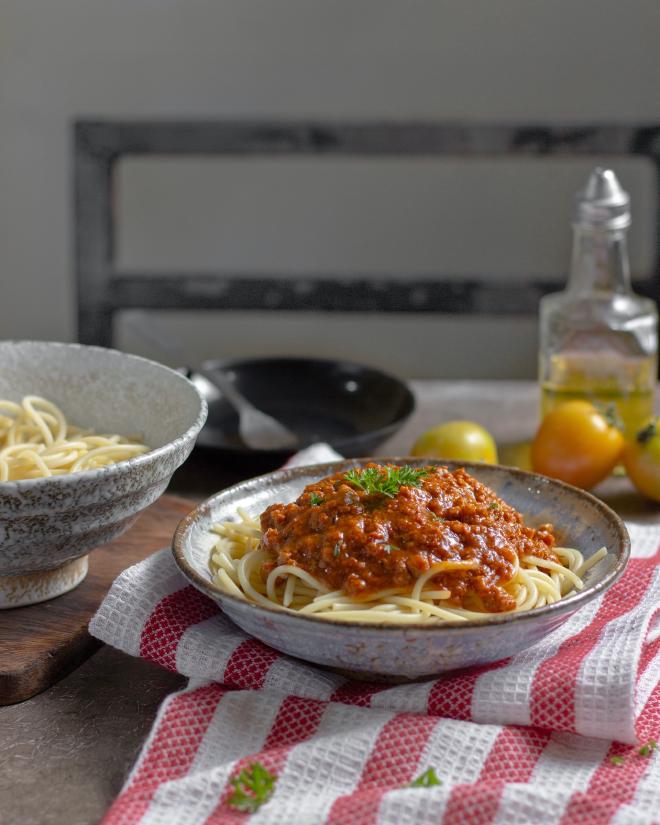Reference Recipe: Spaghetti Bolognese
Table of Contents
Jump to Recipe
Jump to Carbon Footprint
To give you a better idea of how climate-friendly different recipes are, I have used some reference recipes for comparison. These classic recipes are not necessarily the most climate-friendly, but serve as a benchmark for all other recipes. The following article is one of these reference recipes

Spaghetti Bolognese is one of my absolute childhood memories of sitting at my grandmother’s table - she called it “pasta asciutta”: I don’t know why she used this term, and I remember that as a child it took me quite a long time to understand that it was the same dish that was called “spaghetti bolognese” everywhere else. There are about 700 variations on the recipe - here is one that is pretty close to my grandmother’s: I don’t remember any celery or red wine in the sauce, and she hardly ever used spices like thyme, oregano, or basil.
Recipe #
Reference recipeSpaghetti Bolognese
30 minutes
2 portions
Ingredients #
- 20 g olive oil
- 1 onion
- 1 garlic clove
- 250 g minced beef
- 75 g carrots
- 1 tablespoon tomato puree
- 400 ml chunky tomatoes from the tin
- Paprika powder, salt, pepper
- 250 g spaghetti
- 30 g Parmesan cheese, to serve
Directions #
- Finely dice the onion and garlic and sauté in a frying pan with olive oil.
- When the onion is translucent, add the minced beef and fry until it turns grey and loses a little water.
- Dice the carrots and add with the tomato puree. Fry for a further 3 minutes.
- Add the can of tomatoes and a pinch of salt, pepper, and paprika powder. Cover the pan and cook on low heat.
- In a second pan, bring water to a boil, add salt, and cook the spaghetti.
- When the spaghetti is ready, serve: Season the Bolognese sauce to taste, adding a little of the cooking water from the spaghetti if necessary to thicken the sauce. Drain the spaghetti and serve with the sauce and grated Parmesan.
Carbon Footprint #
In total, two portions of Spaghetti Bolognese have an estimated carbon footprint of 3826 g. This is mainly due to the minced beef: as shown in the graph below, this accounts for around 60% of the emissions from Spaghetti Bolognese, with the pasta and tomatoes playing a minor role.
This ranks it number 54 out of 57 recipes published on the blog so far in terms of estimated carbon footprint.
In other words, it is one of the five recipes with the worst carbon footprint. 😱| ingredient | carbon footprint per kg | carbon footprint (in g) for 2 servings | % of ingredients | % of CO2 emissions |
|---|---|---|---|---|
| Olive oil | 3.2 | 165 | 2% | 2% |
| Onion | 0.2 | 86 | 7% | 0% |
| Garlic | 0.5 | 357 | 0% | 0% |
| Beef mince | 9.2 | 2300 | 22% | 60% |
| Carrots | 0.1 | 8 | 7% | 0% |
| Tomato paste | 4.3 | 86 | 2% | 2% |
| Canned tomatoes | 1.8 | 720 | 35% | 19% |
| Paprika powder | 1.1 | 1 | 0% | 0% |
| Salt | 1.4 | 1 | 0% | 0% |
| Pepper | 1.4 | 1 | 0% | 0% |
| Spaghetti | 0.7 | 175 | 22% | 5% |
| Parmesan | 6.3 | 189 | 3% | 5% |
| Cook sauce (20min) | 165 | 4% | ||
| Cooking spaghetti (10min) | 99 | 3% |


